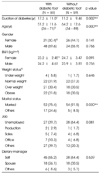Abstract
Objectives
This study was to determine diabetes fatalism of diabetic patients with and without diabetic foot and its association with lifestyle, diet, and self-care.
Methods
The subjects were diabetic patients with (male/female 48/21) and without diabetic foot (male/female 33/26). We administered the questionnaires which were designed to determine diabetes fatalism, lifestyle, diet, and self-care. Diabetes fatalism was determined by Diabetes fatalism scale (DFS), which consisted of total 12 items in three subscales namely, emotional stress, religiou.spiritual coping, and perceived self-efficacy.
Results
The patients with diabetic foot had undesirable diets more frequently (1.37 and 0.91 days/week respectively) and their desirable diets (2.74 and 3.61 days/week respectively) and foot care (4.61 and 5.53 days/week respectively) were less frequent than those without diabetic foot (p < 0.05). An item analysis of the 12 DFS items revealed a Chronbach' α of 0.614 and 0.869, respectively in diabetic patients with and without diabetic foot. Perceived self-efficacy related DFS of subjects without diabetic foot was positively associated with smoking (r = 0.350, p < 0.01), undesirable diet (r = 0.295, p < 0.05), and drinking (r = 0.257, p < 0.05), while its negative association with exercise (r = -0.224, p < 0.088) and foot care (r = -0.247, p < 0.059) did not reach to statistical significance.
Conclusions
This work was the first study reporting the potential usefulness of DFS, especially perceived self-efficacy related subscale as a predictor of lifestyle, diet and self-care on the Korean diabetic patients, at least those without severe diabetic foot to screen those who should be the first target for diabetes education.
Figures and Tables
Table 3
Item wording and descriptive statistics of diabetes fatalism scale in subjects with and without diabetes foot

References
1. Aljasem LI, Peyrot M, Wissow L, Rubin RR. The impact of barriers and self-efficacy on self-care behaviors in type 2 diabetes. Diabetes Educ. 2001; 27(3):393–404.
2. Bains SS, Edege LE. Associations between health literacy, diabetes knowledge, self-care behaviors, and glycemic control in a low income population with type 2 diabetes. Diabetes Technol Ther. 2011; 13:335–341.
3. Choi JH. Lifestyle, diet, and diabetes fatalism of patients with diabetic foot. Daejin University;2014. 7. MS thesis.
4. Chung CH, Kim DJ, Kim JY, Kim HY, Min KW, Park SW, Park JH, Baik SH, Son HS, Ahn CW, Oh JY, Lee SH, Lee JY, Choi KM, Choi IJ, Park IB. Current status of diabetic foot in Korean patients using national health insurance database. J Korean Diabetes Assoc. 2006; 30(5):372–376.
5. Whiting DR, Guariguata L, Weil C, Shaw J. IDF diabetes atlas: global estimates of the prevalence of diabetes for 2011 and 2030. Diabetes Res Clin Pract. 2011; 94(3):311–321.
6. Delamater AM, Jacobson AM, Anderson B, Cox D, Fisher L, Lustman P, Rubin R, Wysocki T. Psychosocial therapies in diabetes: report of the psychosocial therapies working group. Diabetes Care. 2001; 24(7):1286–1292.
7. Egede LE, Ellis C. Development and psychometric properties of the 12-item diabetes fatalism scale. J Gen Intern Med. 2009; 25(1):61–66.
8. Han SS, Lee SC. Nursing and Health statistical analysis. Seoul: Hannarae Academy;2012. p. 279.
9. International Diabetes Federation. IDF Diabetes Atlas. 5th ed. Brussels, Belgium: International Diabetes Federation;2011.
10. Jang SM, Choi KA, Yoo HJ. Alcohol drinking problems anddiabetes self-care in male diabetes. J Korean Diabetes Assoc. 2004; 28(2):139–148.
11. Korean Society for the Study of Obesity. WHO/IASO/IOTF: The Asia-Pacific perspective : Redefining obesity and its treatment. 2000.
12. Kwon YJ, Han KA, Sung SK, Yoo HJ. A clinical study on the diabetic foot lesions. J Korean Diabetes Assoc. 1989; 13(1):39–45.
13. Lee JH, Chung CH. Diabetic foot: Past and present. J Korean Diabetes. 2011; 12(2):69–71.
14. Lee JR. Lifestyle modification and diabetes management. J Korean Diabetes. 2011; 12(4):215–218.
15. Lee YR, Kang MA, Kim PG. The effects of an admissioneducation program on knowledge, self-efficacy, self-care and glucose control in type 2 diabetes patients. J Korean Acad Soc Nurs Educ. 2008; 14(1):12–19.
16. Ministry of Health & Welfare. Korea Centers for Disease Control & Prevention. Korea Health Statistics 2011 : Korea National Health and Nutrition Examination Survey (KNHANES V-2). 2012. cited June 27, 2013. Available from http://knhanes.cdc.go.kr/.
17. Osborn CY, Bains SS, Egede LE. Health literacy, diabtes selfcare, and glycemic control in adults with type 2 diabetes. Diabetes Technol Ther. 2010; 12(11):913–919.
18. Park BS, Jin GN, Choi YC, Chung JH, Koh JH, Chung CH. Self-management and health-related quality of life in adolescent and adulthood diabetic patients. J Korean Diabetes Assoc. 2005; 29(3):254–261.
19. Park JY, Ko IS. Development of a comprehensive selfmanagement program promoting self efficacy for type 2 diabetic patients. J Korean Acad Fundam Nurs. 2012; 19(1):74–86.
20. The Korean Diabetes Association. Preventive foot care in diabetes. Clin Diabetes. 2005; 6(3,4):192–194.
21. Toobert DJ, Hampson SE, Glasgow RE. The summary of diabetes self-care activities measure: results from 7 studies and a revised scale. Diabetes Care. 2000; 23(7):943–950.
22. Yoo JW. What is needed for early detection of diabetes complications? J Korean Diabetes. 2013; 14(1):32–35.
23. Walker RJ, Smalls BL, Hernandez-Tejada MA, Campbell JA, Davis KS, Egede LE. Effect of diabetes fatalism on medication adherence and self-care behaviors in adults with diabetes. Gen Hosp Psychiatry. 2012; 34(6):598–603.
24. Wycherley TP, Mohr P, Noakes M, Clifton PM, Brinkworth GD. Self-reported facilitators of, and impediments to maintenance of healthy lifestyle behaviors following a supervised research-based lifestyle intervention programme in patients with type 2 diabetes. Diabet Med. 2012; 29(5):632–639.




 PDF
PDF ePub
ePub Citation
Citation Print
Print






 XML Download
XML Download